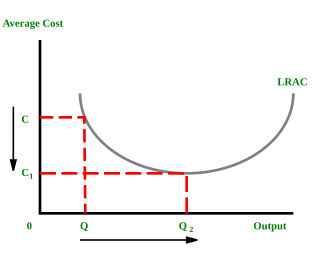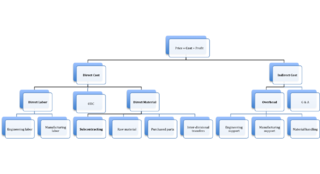Related Research Articles

In microeconomics, economies of scale are the cost advantages that enterprises obtain due to their scale of operation, and are typically measured by the amount of output produced per unit of time. A decrease in cost per unit of output enables an increase in scale. At the basis of economies of scale, there may be technical, statistical, organizational or related factors to the degree of market control.

Cost accounting is defined by the Institute of Management Accountants as "a systematic set of procedures for recording and reporting measurements of the cost of manufacturing goods and performing services in the aggregate and in detail. It includes methods for recognizing,allocating, aggregating and reporting such costs and comparing them with standard costs". Often considered a subset of managerial accounting, its end goal is to advise the management on how to optimize business practices and processes based on cost efficiency and capability. Cost accounting provides the detailed cost information that management needs to control current operations and plan for the future.

In management accounting or managerial accounting, managers use accounting information in decision-making and to assist in the management and performance of their control functions.
Economies of scope are "efficiencies formed by variety, not volume". In economics, "economies" is synonymous with cost savings and "scope" is synonymous with broadening production/services through diversified products. Economies of scope is an economic theory stating that average total cost of production decrease as a result of increasing the number of different goods produced. For example, a gas station that sells gasoline can sell soda, milk, baked goods, etc. through their customer service representatives and thus gasoline companies achieve economies of scope.

Cost of goods sold (COGS) is the carrying value of goods sold during a particular period.

The break-even point (BEP) in economics, business—and specifically cost accounting—is the point at which total cost and total revenue are equal, i.e. "even". There is no net loss or gain, and one has "broken even", though opportunity costs have been paid and capital has received the risk-adjusted, expected return. In short, all costs that must be paid are paid, and there is neither profit nor loss. The break-even analysis was developed by Karl Bücher and Johann Friedrich Schär.
In economics, the marginal cost is the change in the total cost that arises when the quantity produced is increased, i.e. the cost of producing additional quantity. In some contexts, it refers to an increment of one unit of output, and in others it refers to the rate of change of total cost as output is increased by an infinitesimal amount. As Figure 1 shows, the marginal cost is measured in dollars per unit, whereas total cost is in dollars, and the marginal cost is the slope of the total cost, the rate at which it increases with output. Marginal cost is different from average cost, which is the total cost divided by the number of units produced.
In economics, average cost (AC) or unit cost is equal to total cost (TC) divided by the number of units of a good produced :

Activity-based costing (ABC) is a costing method that identifies activities in an organization and assigns the cost of each activity to all products and services according to the actual consumption by each. Therefore, this model assigns more indirect costs (overhead) into direct costs compared to conventional costing.

Variable costs are costs that change as the quantity of the good or service that a business produces changes. Variable costs are the sum of marginal costs over all units produced. They can also be considered normal costs. Fixed costs and variable costs make up the two components of total cost. Direct costs are costs that can easily be associated with a particular cost object. However, not all variable costs are direct costs. For example, variable manufacturing overhead costs are variable costs that are indirect costs, not direct costs. Variable costs are sometimes called unit-level costs as they vary with the number of units produced.

Contribution margin (CM), or dollar contribution per unit, is the selling price per unit minus the variable cost per unit. "Contribution" represents the portion of sales revenue that is not consumed by variable costs and so contributes to the coverage of fixed costs. This concept is one of the key building blocks of break-even analysis.
In accounting and economics, a semi-variable cost is an expense which contains both a fixed-cost component and a variable-cost component. It is often used to project financial performance at different scales of production. It is related to the scale of production within the business where there is a fixed cost which remains constant across all scales of production while the variable cost increases proportionally to production levels.
Indirect costs are costs that are not directly accountable to a cost object. Like direct costs, indirect costs may be either fixed or variable. Indirect costs include administration, personnel and security costs. These are those costs which are not directly related to production. Some indirect costs may be overhead, but other overhead costs can be directly attributed to a project and are direct costs.
Total absorption costing (TAC) is a method of Accounting cost which entails the full cost of manufacturing or providing a service. TAC includes not just the costs of materials and labour, but also of all manufacturing overheads. The cost of each cost center can be direct or indirect. The direct cost can be easily identified with individual cost centers. Whereas indirect cost cannot be easily identified with the cost center. The distribution of overhead among the departments is called apportionment.
Job costing is accounting which tracks the costs and revenues by "job" and enables standardized reporting of profitability by job. For an accounting system to support job costing, it must allow job numbers to be assigned to individual items of expenses and revenues. A job can be defined to be a specific project done for one customer, or a single unit of product manufactured, or a batch of units of the same type that are produced together.

Cost–volume–profit (CVP), in managerial economics, is a form of cost accounting. It is a simplified model, useful for elementary instruction and for short-run decisions.
Cost pools is an accounting term that refers to groups of accounts serving to express the cost of goods and service allocatable within a business or manufacturing organization. The principle behind the pool is to correlate direct and indirect costs with a specified cost driver, so to find out the total sum of expenses related to the manufacture of a product.
The following is a glossary of terms relating to construction cost estimating.

In business economics cost breakdown analysis is a method of cost analysis, which itemizes the cost of a certain product or service into its various components, the so-called cost drivers. The cost breakdown analysis is a popular cost reduction strategy and a viable opportunity for businesses.
The UVA method is an accounting and decision-making tool, based on calculating the cost of sales. Unlike management accounting, which calculates product margins, the UVA method calculates the result generated by each sale. The UVA method relies on a very detailed analysis of all costs related to products, customers, orders, and deliveries. It introduces the notion of a single measure unit, which applies to all the operations in the company. The method relies on an equivalent-based approach.
References
- ↑ Porter, M., Competitive Advantage, [ page needed ]
- ↑ Strategic Cost Management: The New Tool for Competitive Advantage by Shank and Govindarajan